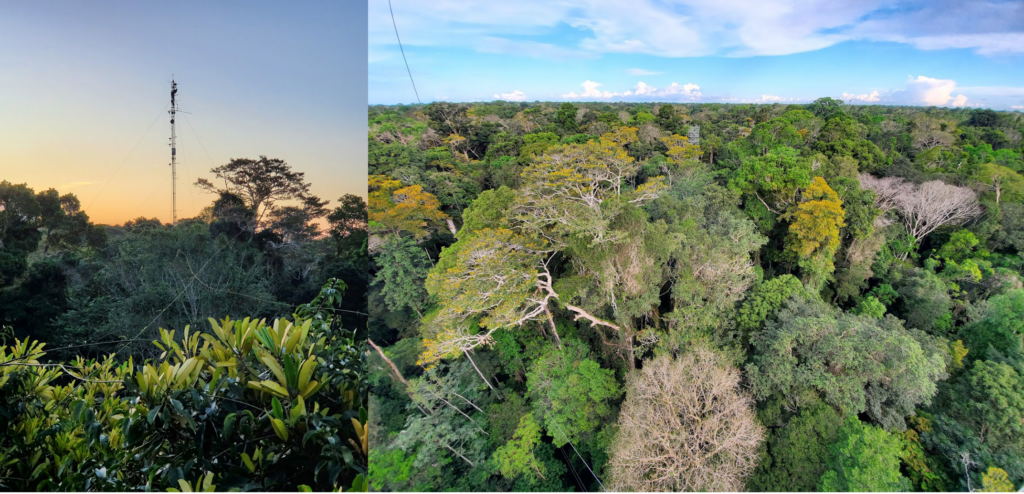Using data from a 65-m tall flux tower in the Amazon, researchers found that a hot drought in 2015 had lasting impacts on leaf abundance and water cycle.

Instrumented eddy covariance tower (left) at the Tapajós National Forest, Brazil, and the forest as seen from the tower (right). Data from the tower were used to study how water and energy cycles in the Amazon respond to extreme dry and extreme wet years. Photos by Natalia Restrepo-Coupe.
The Science
Droughts and very rainy years are both becoming more common in the Amazon because of climate change. Researchers used a long time series of data collected from a tower in the middle of the Amazon to study how water exchange between plants and the atmosphere (evapotranspiration) varies during droughts and rainy periods. They found that when rain is abundant, evapotranspiration barely changes. In contrast, during the El Niño drought of 2015, evapotranspiration was low, because plants lost leaves or stopped transpiring. They also found that recovery after drought was slow.
The Impact
The Amazon forest is very important for the earth’s water and energy cycles. The team found that the recent drought in 2015 was hotter and drier than previous droughts because of climate change. This result is important because the impacts of this drought on leaf abundance were stronger, lasted longer, and changed how the forest interacted with the atmosphere. If droughts become too frequent, the forest may not have enough time to recover before the next drought hits the forest. This could permanently shift the Amazon water cycle.
Summary
Over the past decades, the Amazon forests experienced multiple extreme droughts and wet years. This research used data collected between 2001 and 2020 at an eddy covariance tower at the Tapajós National Forest (Brazil) to study how evapotranspiration and sensible heat flux varied during periods of drought and excessive rain. The team also implemented a model that separates the contribution of plants (transpiration) and soil (evaporation) to the water fluxes. The long time series included a strong La Niña wet event (2008-2009) and a strong El Niño drought (2015-2016).
The team found that the La Niña event did not affect evapotranspiration and sensible heat fluxes. The magnitude and the seasonal cycles of all fluxes were similar between the wet and normal years. However, during the El Niño event, many plants closed their stomata or lost leaves. This impact resulted in lower transpiration and higher sensible heat fluxes, indicating water stress. Moreover, the forest did not return to normal conditions until one year after the drought had ended. The slow recovery suggests that the Amazon forest was close to reaching a tipping point during the 2015 drought, which could have resulted in long-lasting changes in the forest.
Contacts
Natalia Restrepo-Coupe
Department of Ecology and Evolutionary Biology, The University of Arizona
nataliacoupe@gmail.com
Marcos Longo
Lawrence Berkeley National Laboratory
mlongo@lbl.gov
Funding
This research was supported by the Next Generation Ecosystem Experiments-Tropics, funded by the U.S. Department of Energy, Office of Science, Office of Biological and Environmental Research. The measurements at the Tapajós National Forest were supported by multiple projects, including the Brazilian-led Large scale Biosphere Atmosphere experiment in Amazonia, the National Aeronautics and Space Administration, the GoAmazon project (jointly funded by the U. S. Department of Energy, Office of Science, and the Brazilian science foundations FAPESP and FAPEAM), and the U. S. National Science Foundation (NSF).
Publications
Restrepo-Coupe, N., B. O. Christoffersen, M. Longo, L. Alves, K. S. Campos, A. C. de Araújo, R. C. de Oliveira Jr., N. Prohaska, R. da Silva, R. Tapajós, K. T. Wiedemann, S. C. Wofsy, S. R. Saleska. “Asymmetric response of Amazon forest water and energy fluxes to wet and dry hydrological extremes reveals onset of a local drought-induced tipping point.” Global Change Biology (2023). https://doi.org/10.1111/gcb.16933